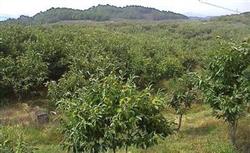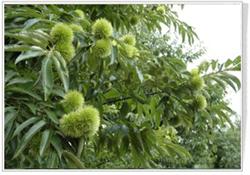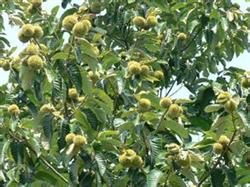Cultivation and Management of Chinese Chestnut

Castanea mollissima is a famous fine dried fruit tree of Fagaceae. Chinese people have thousands of years of cultivation history and accumulated rich experience. It occupies an important position in the economic life of our people. Chinese chestnut is rich in nutrition and delicious. It can be eaten fresh, fried, cooked and made all kinds of snacks and dishes. It not only has the characteristics of sweetness, fragrance and waxy, but also has the function of treating spleen and liver and strengthening the body, so it is famous at home and abroad, and it is called Chinese chestnut in the international market. People in the producing area call it an iron crop. First, the characteristics are cultivated in most parts of our country. Castanea mollissima is a positive tree species with light-loving, deep roots and crown development. The soil is not strict and slightly acidic, and ph4.6-7.5 is suitable, and the gravelly loam with deep and fertile soil layer, moist and good drainage is the most favorable for growth. The chestnut tree is about 20 meters high and the bark is irregularly deeply split; the branchlets are densely gray-white tomentose, and the leaves are long oval to long elliptic-lanceolate, 9mur18 cm long and 4mi 7 cm wide, with gray-white stellate hairs and tomentose underneath. The male inflorescence is 9-20 cm long, the female flowers are mostly born at the base of the male inflorescence, often 3 flowers are concentrated in the involucre, the shell is globose, there are stellate hairs on the spines, 3 nuts are 2-Mel, 3 cm in diameter, often one or both sides are nearly flattened, dark brown, flowering from May to June every year, and the fruit is ripe from September to October. The branches distribute different types, such as breeding branch, fruiting branch, male flower branch, long branch and so on. Developmental branches: developed from leaf buds and stable buds. Strong growth is the basis for the formation of backbone branches of the crown; fruiting branches: newly born branches from the mother tree, bearing female and male flowers, blooming and fruiting branches; fruiting mother branches: the branches bearing mixed buds are fruiting mother shoots, the lower buds produce developmental branches and male inflorescences, and the several buds near the base do not germinate. Male flower branch: a branch produced by incomplete mixed buds, bearing only male inflorescences; elongated branches: long, erect shoots that sprout when hidden buds and leaf buds are stimulated. Among them, the new shoots sprouting near the trunk grow vigorously and are not easy to be transformed into fruit branches, while the new shoots sprouting in the middle and upper part of the main side branches grow slowly and can be transformed into fruit branches in 2-3 years. Overgrown branches occur more in young trees, and some of them can be selected as trunk branches, while those in old trees occur less, which is a good branch for renewal and rejuvenation. Second, the quality of seedlings in cultivation techniques directly affects the survival rate of cultivation, the growth and fruit of young trees, so we must pay attention to the quality of seedlings and cultivate high-quality strong seedlings in the development of chestnut production. Grafting breeding technology: grafting can maintain the characteristics of excellent varieties, and can bear fruit earlier. Chinese chestnut and Quercus variabilis seedlings, which are 1-4 years old and about 4 cm thick, are selected as rootstocks. On the mother tree with excellent variety and strong growth, the one-year-old stout fruiting branch was selected as the scion. The grafting time is generally from late February to April. The grafting methods can be split grafting, double tongue grafting, abdominal grafting, skin grafting, skin grafting and ventral grafting. In order to improve the survival rate of grafting, the scion could be treated with 15% naphthalene acetic acid for 24 hours. Rootstocks are cultivated in the nursery for grafting and then planted. You can also plant rootstocks first, graft after survival, set up branches to support new shoots, pay attention to fertilization, watering, loosening soil, weeding, remove bandaging after growing for 1-2 months, and coring when the new shoots are 40ml / 50cm in height to thicken the growth of seedlings and promote scion branching. At the same time, we should always pay attention to the removal of germination strips and root tiller strips to avoid competing with scions for nutrients. Seed breeding techniques: the middle-aged chestnut trees with excellent varieties, strong growth and no diseases and insect pests were selected as the mother tree. The seeds should be large, thin and fully mature. near the woodland, choose the place with flat terrain, fertile soil, good drainage and convenient irrigation as the nursery. Open the trench according to the row spacing of 25 Mel 30 cm, press the plant spacing of 10 mi 15 cm, put the seeds horizontally in the ditch, then cover the soil with 3 mi 4 cm, and press the close connection between the seeds and the soil. The seeds were sown at 70 Mu and 100 kg per mu, and the seedlings were unearthed in about 20 days. After emergence, pay attention to loosening soil, weeding, irrigation, topdressing 2 Mel 3 times from June to July, 1-year-old seedlings as high as 50 mi 70 cm, can be out of the nursery for afforestation. In the afforestation of Castanea mollissima, the planting hole is 1 × 1 × 1 m, and the base fertilizer is applied. According to the variety, soil quality, slope and intercropping between forest and farmers, the row spacing is determined. The fertile soil is 8 × 8 m, generally 5 × 5 m. In the afforestation season, it is better before the sap flows in winter and spring, pay attention to watering enough root water when planting, and often water it according to the soil moisture in the dry season. Third, tending and management of Chinese chestnut orchard should carry out loosening soil, weeding and cutting miscellaneous trees every year, so as to mature the soil, reduce water evaporation, promote the growth and development of trees, and reduce diseases and insect pests. Loosen the soil and weed in spring and autumn every year. Forest-grain intercropping is carried out where there are conditions, and the intercropping crops include bract millet, peanuts, legumes, potatoes and so on. Chestnut trees are sensitive to fertilization, which can increase the yield by 10%, 20% in that year and more than double in the second year. Fertilizer is mainly organic fertilizer, combined with chemical fertilizer. Organic fertilizer is applied in annular ditch in winter, chemical fertilizer is applied in spring and summer, and radial or acupoint application is better. Correct pruning is also one of the important measures to increase production of Chinese chestnut. The pruning of young trees should have low stem and low crown. The canopy should be carried out, generally with evacuation and stratification semicircle, ventilation and light, which is beneficial to the growth and fruit of the tree. The shaping methods are as follows: dry height 60ml 100cm, main branches 5Mel 6, 2Mel 3 layers, the first layer 2Mel 3, the second layer 1Mel 2, and the third layer 1. The weak branches below the elongated branches of the main and lateral branches should be removed. Pay attention to the opening angle during plastic surgery, cut off endophytic branches, thin and weak branches, and overgrown branches, and retain oblique and extended exogenous branches to maintain the sparse shape of the tree. Chestnut wood is light brown, straight texture, thick structure, heavy and hard, resistant to rot and moisture, for sleepers, pillars, vehicles, farm tools and so on. Logs can also cultivate mushrooms. The pulp of bark, twig and wood all contain tannin, which can be extracted from tannin. Leaves can raise tussah silkworms. Flowers are also a good source of honey. Chinese chestnut is not only a treasure in the whole body, but also has strong adaptability, drought and waterlogging resistance, easy cultivation and management, one hundred years of harvest, strong disease resistance and stable yield. The development of chestnut production is of great significance to the development of mountain economy and the improvement of farmers' lives.
- Prev

Comprehensive high-yield technology of Chinese chestnut
1. Close planting and reasonable close planting can not only increase the early yield and obtain economic benefits as soon as possible, but also facilitate the intensive management of orchards. Planting density: the plant row spacing is generally 2m × 4m and 3m × 4m or 3m × 5m. The specific density depends on the characteristics of rootstock, scion or site conditions. It can be recovered within 6 years after planting.
- Next

Summer fertilization of Chinese Chestnut
In order to improve the yield and quality of Chinese chestnut, chestnut trees should be fertilized in summer. there are two main fertilization methods: soil fertilizer method: the soil fertilizer method is better in the chestnut orchard with thin soil and serious lack of fertilizer. In the chestnut crown drip line, dig a circular ditch for fertilization, 25 cm wide and 2 cm deep.
Related
- Moge, come on! The staff of the peasant association in the producing area of cantaloupe were frightened when the crowd gathered.
- Causes and Solutions of low Fruit setting rate of Apple
- Symptoms and control measures of passion fruit virus disease
- Fruit growing lesson: how do apple orchards keep high yields?
- Can you build orchards in the mountains? What are the pros and cons?
- How to manage the coloring period of Crisson grape?
- This paper introduces the processing technology of two kinds of fig products.
- How much is a month for retired teachers in rural areas by 2020?
- How can strawberry planting increase sugar content? We should pay attention to management in many aspects.
- What are the cultivation techniques on how to improve the yield of golden fruit?

